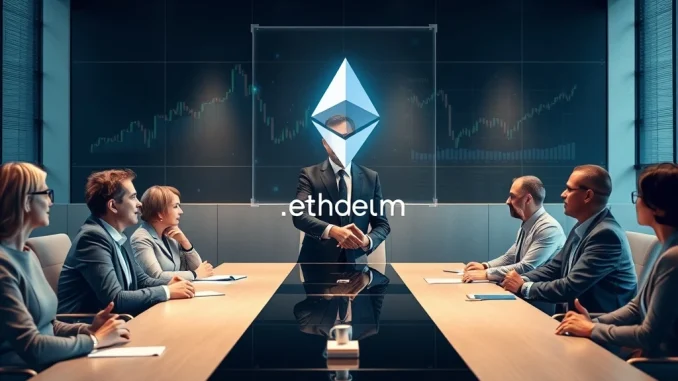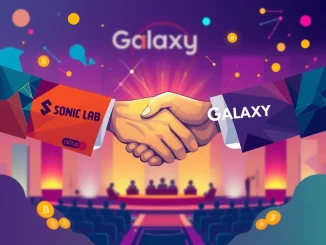
In a groundbreaking development that has sent ripples across the cryptocurrency landscape, BlackRock veteran Joseph Chalom has joined SharpLink Gaming, Inc. as Co-CEO. This strategic appointment signals a monumental shift for SharpLink, pivoting its core operations towards an innovative Ethereum Treasury Strategy. This move isn’t just a corporate reshuffle; it’s a powerful endorsement of Ethereum’s long-term viability and its growing role in mainstream finance. For anyone following Ethereum News, this is a moment that highlights the accelerating convergence of traditional finance and the decentralized world.
Who is Joseph Chalom and Why is His Move So Pivotal?
Joseph Chalom is no stranger to the world of high finance and digital assets. Before his groundbreaking move to SharpLink, he was a key architect of BlackRock’s digital asset initiatives. His tenure at the world’s largest asset manager included pivotal roles in launching landmark products such as the iShares Bitcoin Trust ETF (IBIT) and the iShares Ethereum Trust ETF (ETHA). He was also instrumental in the development of BlackRock’s tokenization fund, BUILD. These achievements underscore his deep understanding of both traditional investment frameworks and the burgeoning crypto ecosystem. His departure from BlackRock in June 2025 and subsequent appointment at SharpLink Gaming, Inc. speaks volumes.
Chalom’s decision to transition from a giant like BlackRock to a company embarking on a crypto-native treasury strategy reflects a broader trend: institutional leaders are moving beyond passive investment vehicles. They are increasingly engaging directly with protocol development, token economics, and active asset management within the blockchain space. His expertise isn’t just about launching products; it’s about understanding how digital assets can be integrated into core business models, optimized for yield, and managed strategically. This makes his new role at SharpLink a critical barometer for the future direction of institutional engagement with decentralized finance.
SharpLink Gaming’s Bold New Direction: A Deep Dive into the Ethereum Treasury Strategy
SharpLink Gaming, Inc., which rebranded in May 2025, is now making headlines for its audacious pivot. The company has amassed an astounding 360,807 ETH, a figure that reportedly surpasses even the Ethereum Foundation’s holdings. This makes SharpLink the largest corporate holder of ETH, representing approximately 0.2% of Ethereum’s total supply. But their strategy goes far beyond simply holding assets.
Under Chalom’s leadership, SharpLink aims to actively leverage its substantial Ethereum treasury through a sophisticated suite of strategies, including:
- Staking: Participating in Ethereum’s proof-of-stake consensus mechanism to earn rewards.
- Restaking: A newer, more advanced form of staking that allows staked ETH to be re-pledged to secure other decentralized networks, potentially generating additional yield.
- Yield Optimization: Employing various DeFi protocols and strategies to maximize returns on their ETH holdings, going beyond simple staking to explore lending, liquidity provision, and other yield-generating opportunities.
This strategic shift transforms SharpLink from a performance marketing firm into a major corporate ETH treasury manager. It underscores a commitment to Ethereum’s post-merge proof-of-stake ecosystem, emphasizing decentralized finance (DeFi) protocols and on-chain activity. The goal is to drive utility beyond speculative trading, showcasing Ethereum’s potential as a productive asset class for corporate balance sheets.
Why Ethereum Now? Fueling Institutional Ethereum Adoption
The choice of Ethereum as the cornerstone of SharpLink’s treasury strategy is highly significant and reflects a growing trend in Institutional Ethereum Adoption. Ethereum’s robust ecosystem, its transition to proof-of-stake, and its vibrant DeFi landscape make it an attractive asset for yield-seeking institutions. Here’s why this move resonates with broader market trends:
- Proof-of-Stake Stability: Ethereum’s transition to PoS has made it more energy-efficient and scalable, offering a more predictable and sustainable yield mechanism through staking.
- DeFi Ecosystem Maturity: The sheer depth and breadth of decentralized applications (dApps) on Ethereum provide diverse avenues for yield generation and utility, moving beyond mere price speculation.
- Institutional Credibility: Chalom’s prior work at BlackRock, particularly the launch of the ETHA ETF, significantly bolstered Ethereum’s credibility within traditional finance. His direct involvement now further solidifies this perception.
- Market Dynamics: Despite short-term fluctuations, Ethereum’s market dynamics reflect growing institutional confidence. The cryptocurrency has shown significant growth over recent periods, driven by its fundamental utility and ecosystem development.
ConsenSys CEO Joe Lubin, who has joined SharpLink’s board as chairman, described Chalom’s hire as a “massive” endorsement of Ethereum’s long-term viability. This sentiment is echoed by Coincu research, which notes that such high-profile involvement signals potential for a stronger digital finance framework, driven by institutional entities. Historical trends suggest that increased Ethereum adoption could reinforce regulatory norms, market trust, and technological advancements across the crypto space.
Navigating the Hybrid Model: Opportunities and Challenges
SharpLink’s innovative approach creates a unique hybrid model: a publicly traded equity tied directly to its substantial Ethereum treasury. This structure presents both compelling opportunities and inherent complexities.
Opportunities:
- Access to Crypto-Native Yields: The model could attract institutional investors seeking exposure to crypto-native yields (from staking, restaking, DeFi) without directly navigating the complexities of holding and managing digital assets themselves.
- Bridging TradFi and DeFi: It offers a potential blueprint for how traditional companies can integrate blockchain-native assets and strategies into their core operations, bridging the gap between traditional and decentralized finance.
- Enhanced Shareholder Value: Active management and yield optimization of the ETH treasury could significantly enhance SharpLink’s corporate valuation and shareholder returns, creating a new value proposition.
- Market Influence: As the largest corporate holder of ETH, SharpLink’s strategic alignment with Ethereum’s ecosystem could influence on-chain governance and activity, potentially stabilizing the asset’s price by reducing circulating supply and enhancing demand through active usage.
Challenges:
- Volatility Risk: The value of SharpLink’s equity will inevitably be influenced by Ethereum’s price fluctuations, introducing a new layer of volatility for a publicly traded company.
- Regulatory Uncertainty: Regulatory clarity on corporate token holdings, active yield generation strategies, and the accounting treatment of digital assets remains an evolving area, posing potential risks.
- Operational Complexity: Managing a large, actively utilized crypto treasury requires specialized expertise in security, smart contract risk, and on-chain operations.
While SharpLink has not disclosed specific timelines for deploying all its staking or yield strategies, its clear focus on Ethereum’s proof-of-stake model aligns with broader industry confidence in the asset’s utility and its potential to generate sustainable returns.
What Does This Mean for the Future of Institutional Crypto?
Joseph Chalom’s move from BlackRock to SharpLink Gaming reflects a significant maturation in the cryptocurrency market. It signals a shift where active asset management and yield maximization are becoming key drivers of value creation for institutional players. While BlackRock remains a leader in crypto ETPs, its former executives are increasingly involved in direct blockchain stewardship, mirroring similar moves by major financial institutions expanding their digital asset divisions.
This development suggests that we are moving beyond just passive investment vehicles like ETFs. Institutions are now looking to actively engage with blockchain protocols, participate in token economics, and leverage the inherent yield-generating capabilities of assets like Ethereum. SharpLink’s rebranding and strategic pivot could accelerate Ethereum’s integration into traditional investment frameworks, providing a new model for how corporations interact with decentralized networks.
The implications are far-reaching. SharpLink’s model could democratize access to crypto-native yields for institutional investors, making sophisticated DeFi strategies more accessible through a publicly traded equity. For Ethereum, this shift underscores growing institutional recognition of its utility, potentially boosting demand through active utilization in staking and DeFi applications, rather than just speculative holding. It’s a testament to the evolving landscape where blockchain assets are increasingly seen not just as speculative instruments, but as foundational components of future corporate finance.
Conclusion
The appointment of BlackRock veteran Joseph Chalom as co-CEO of SharpLink Gaming marks a truly transformative moment for both the company and the broader crypto market. By pivoting to an ambitious Ethereum Treasury Strategy and becoming the largest corporate holder of ETH, SharpLink is setting a new precedent for Institutional Ethereum Adoption. This bold move, championed by a figure with deep roots in traditional finance, underscores the increasing confidence in Ethereum’s utility, its robust ecosystem, and its potential for generating significant yield through staking and DeFi.
While challenges related to volatility and regulation remain, the strategic alignment with Ethereum’s proof-of-stake model positions SharpLink at the forefront of a new era where traditional finance and decentralized assets converge. This development is a clear signal that the future of corporate treasuries and institutional investment will increasingly involve active engagement with blockchain technology, paving the way for greater integration and innovation in the global financial landscape. Keep an eye on this space; the ripple effects of SharpLink’s strategic pivot are likely to be felt across the industry for years to come.
Frequently Asked Questions (FAQs)
Q1: Who is Joseph Chalom and what is his background?
Joseph Chalom is a former executive at BlackRock, where he was a key figure in their digital asset initiatives. He played pivotal roles in launching major crypto-related products like the iShares Bitcoin Trust ETF (IBIT) and the iShares Ethereum Trust ETF (ETHA), as well as BlackRock’s tokenization fund, BUILD. His background is deeply rooted in traditional finance with extensive experience in digital assets.
Q2: What is SharpLink Gaming’s new strategy?
SharpLink Gaming, Inc. has pivoted its core strategy to an Ethereum Treasury Strategy. This involves holding a significant amount of Ethereum (ETH) as a core treasury asset and actively managing it through staking, restaking, and various yield optimization strategies within the decentralized finance (DeFi) ecosystem, aiming to generate returns and drive utility beyond mere speculation.
Q3: How much Ethereum does SharpLink Gaming hold?
SharpLink Gaming reportedly holds 360,807 ETH, which makes it the largest corporate holder of Ethereum. This amount represents approximately 0.2% of the total Ethereum supply, surpassing even the Ethereum Foundation’s holdings.
Q4: What are the benefits of this Ethereum Treasury Strategy for SharpLink?
The benefits include potential for generating crypto-native yields through staking and DeFi, enhancing corporate valuation, attracting institutional investors seeking exposure to crypto yields via a publicly traded equity, and positioning SharpLink as a leader in bridging traditional finance with decentralized assets. It also aligns the company with the long-term growth and utility of the Ethereum ecosystem.
Q5: What are the potential challenges or risks associated with this strategy?
Key challenges include the inherent volatility of cryptocurrency prices, which can impact corporate valuation; evolving regulatory landscapes surrounding corporate digital asset holdings and yield generation; and the operational complexities and security risks associated with managing a large, actively utilized crypto treasury on-chain.
Q6: How does this move impact Institutional Ethereum Adoption?
Joseph Chalom’s move to SharpLink and the company’s bold Ethereum Treasury Strategy significantly boosts Institutional Ethereum Adoption. It demonstrates a shift from passive investment in crypto ETFs to active engagement with blockchain protocols and token economics. This could encourage other traditional firms to explore similar models, further legitimizing Ethereum as a foundational asset for corporate balance sheets and active yield generation.



